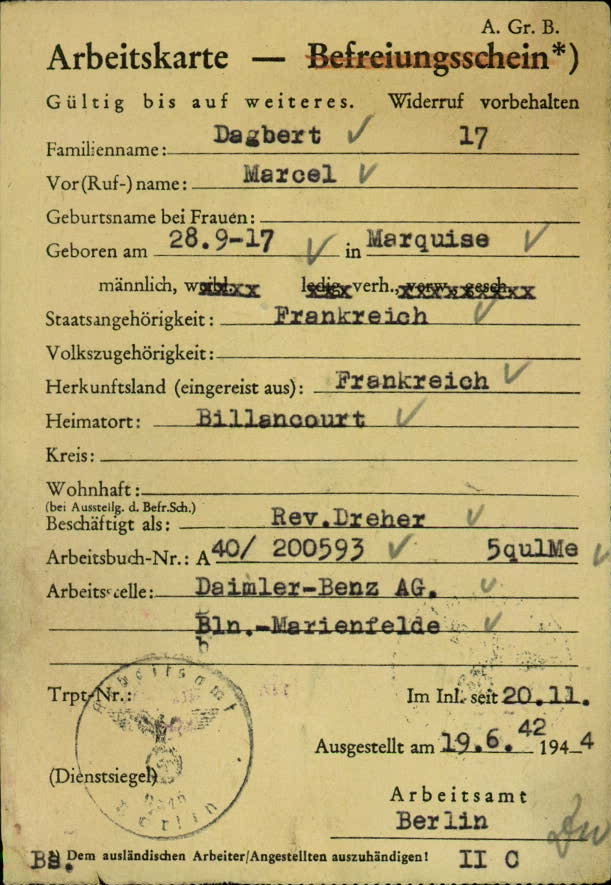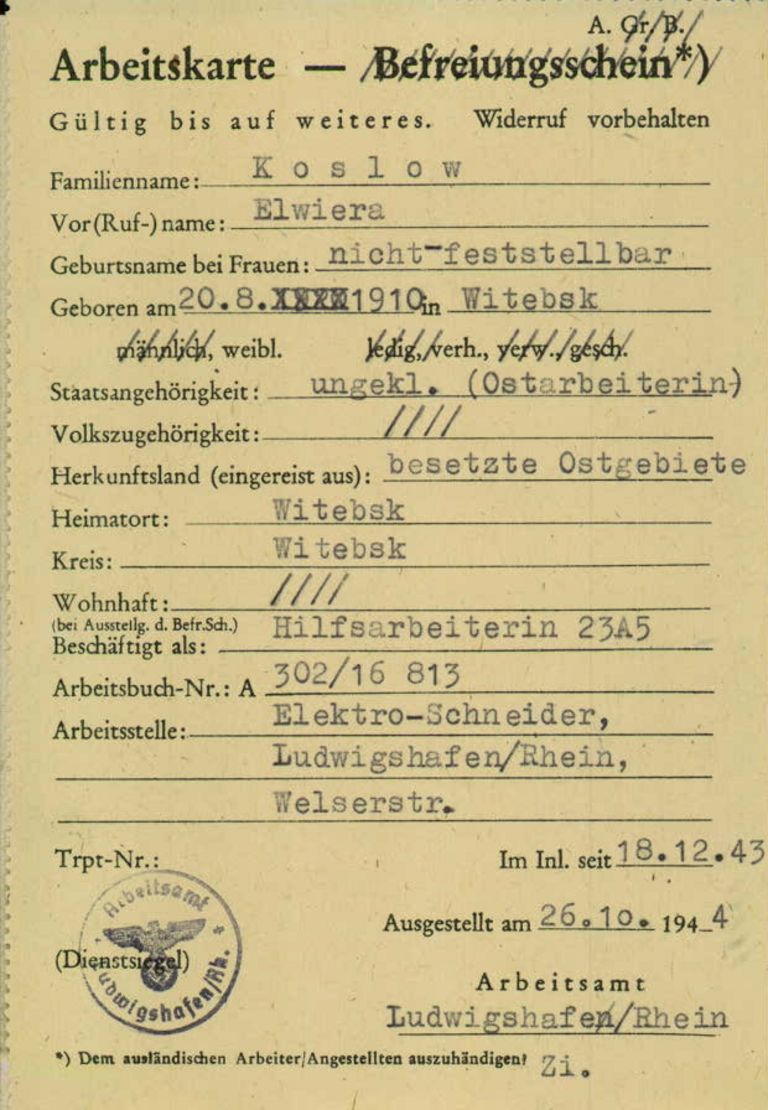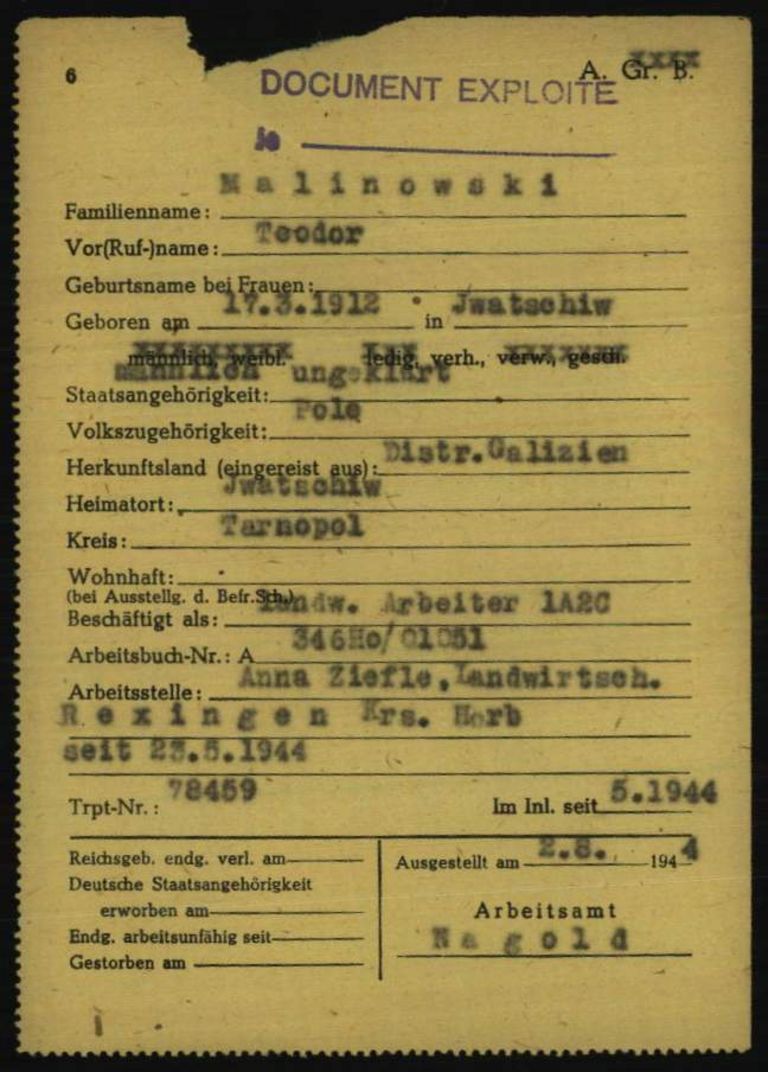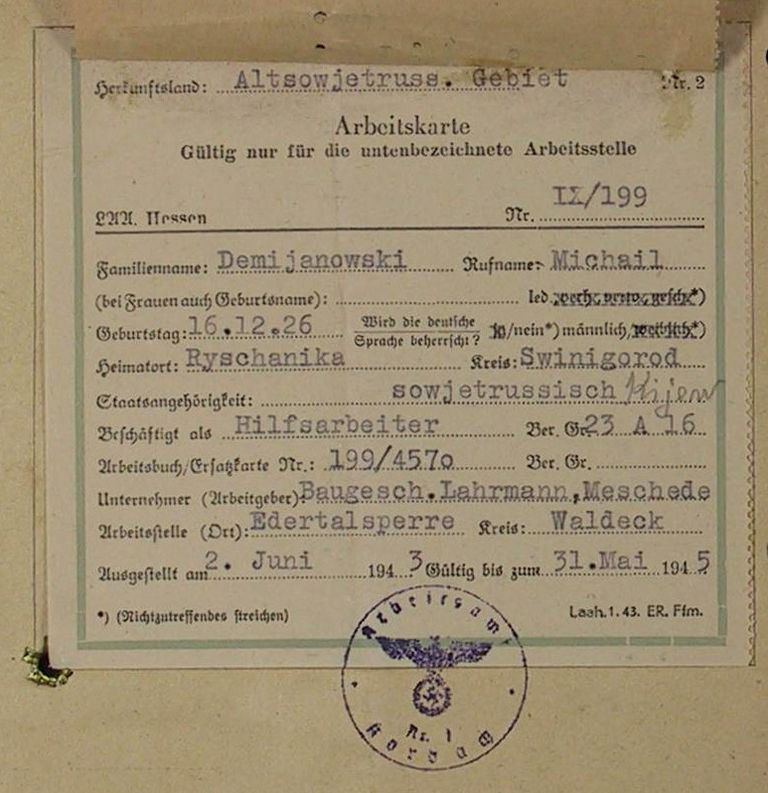Page of
Page/
- Reference
- Intro


All civilian forced laborers in the German Reich required a work permit document (Arbeitserlaubnispapier) from the relevant employment office. It stated the name of the company or other organization to which the person had been assigned. After a change of workplace or when the document had become invalid after two years, employment office staff issued a new work permit document. Labor cards carried by civilian forced laborers as a form of identification were only valid if an up-to-date work permit document was pasted inside them.
All civilian forced laborers in the German Reich required a work permit document (Arbeitserlaubnispapier) from the relevant employment office. It stated the name of the company or other organization to which the person had been assigned. After a change of workplace or when the document had become invalid after two years, employment office staff issued a new work permit document. Labor cards carried by civilian forced laborers as a form of identification were only valid if an up-to-date work permit document was pasted inside them.
Questions and answers
-
Where was the document used and who created it?
The deployment of civilian forced laborers was dependent on approval from the relevant employment office. The same was true for a change from one place of work to another. If employment office staff had approved a company’s application for a worker and had assigned a worker to this employer, they completed the work permit document to substantiate this. This happened in the case of every new assignment and every change of workplace. Four copies of the permit were issued, one for employers, one for the local police authority, one stayed in the employment office and one was pasted inside the labor cards of civilian forced laborers.
- When was the document used?
Starting in 1933, foreign workers required a work permit in order to work in the German Reich. One form of this work permit was the green slip for agricultural workers and the gray slip for industrial or other workers. These slips were introduced by the Nazi labor administration after the beginning of the war in order to simplify the authorization procedure for the steadily growing number of Polish and Soviet civilian laborers. From 1943 onwards, the work permit document replaced the green and gray slips. However, due to the shortage of paper during the war, the Reich Ministry of Labor instructed the employment offices to use up any existing blank forms first. The work permit document and the green or gray slips were therefore sometimes used in parallel. Employment office staff issued work permit documents until the end of the war.
- What was the document used for?
The procedure for being allocated civilian forced laborers was clearly regulated: Employers registered their need for workers with their relevant employment offices. The regional employment offices collated this information and forwarded it to the Reich Employment Office in Berlin. There a central decision was made as to how many civilian forced laborers were to be assigned to armaments factories, and how many to other sectors. Civilian forced laborers in the 45 reception and transit camps, and those engaged in work that was not considered important for the war effort, were then assigned to the individual regional employment offices. These then took over the distribution of civilian forced laborers to the various employers. Work permit documents arose in this context. They were issued by employment office staff as soon as the company or other organization to which a person had been assigned was known.
If it was the first time they had been employed in the German Reich, the employment office staff immediately pasted a copy of the work permit document into the newly created labor cards of the civilian forced laborers and sent both documents to the relevant local police authority. If a change of workplace was involved, they only sent the work permit document. On arrival at their place of work, civilian forced laborers were obliged to report to the relevant police authority. There they received either a labor card or, if they already had one, a work permit document, which was pasted into the labor card they had brought with them. One of the other three copies of the work permit document was kept by the employment office, one by the police authority and the other by the employers. A work permit document was valid for a maximum period of two years or until the person changed their place of work.
- How common is the document?
Employment office staff issued millions of work permit documents. Firstly, a work permit document was only valid for a maximum of two years, and secondly, four new copies were produced every time a civilian forced laborer changed jobs.
Unfortunately, it is impossible to say how many of them have been preserved in the Arolsen Archives. Firstly, staff at the International Tracing Service (ITS), the predecessor institution of the Arolsen Archives, did not collate work permit documents in a separate card index, but sorted them into the War Time Card File (Collection 2.2.2.1), which contains 4.2 million documents. Secondly, work permit documents have also been preserved inside labor cards, and in some cases, several of them have been pasted one on top of the other. But in the near future, modern computer technology will find the answer: clustering techniques will make it possible to identify work permit documents, as well as other documents, and to virtually collate documents of the same type. However, the work permit documents of all civilian forced laborers have by no means survived.
- What should be considered when working with the document?
Work permit documents are often also referred to as labor cards (Arbeitskarten) because of the inscription in the heading. Both labor cards and work permit documents were issued by employment office staff, and a copy of the work permit document was pasted into the labor card. However, these were different documents with different functions. To avoid any inaccuracies, the e-Guide always uses the term “work permit document” to refer to this type of document.
If you have any additional information about this document, please send your feedback to eguide@arolsen-archives.org. The document descriptions in the e-Guide are updated regularly – and the best way for us to do this is by incorporating the knowledge you share with us.
Variations
Help for documents
About the scan of this document <br> Markings on scan <br> Questions and answers about the document <br> More sample cards <br> Variants of the document




